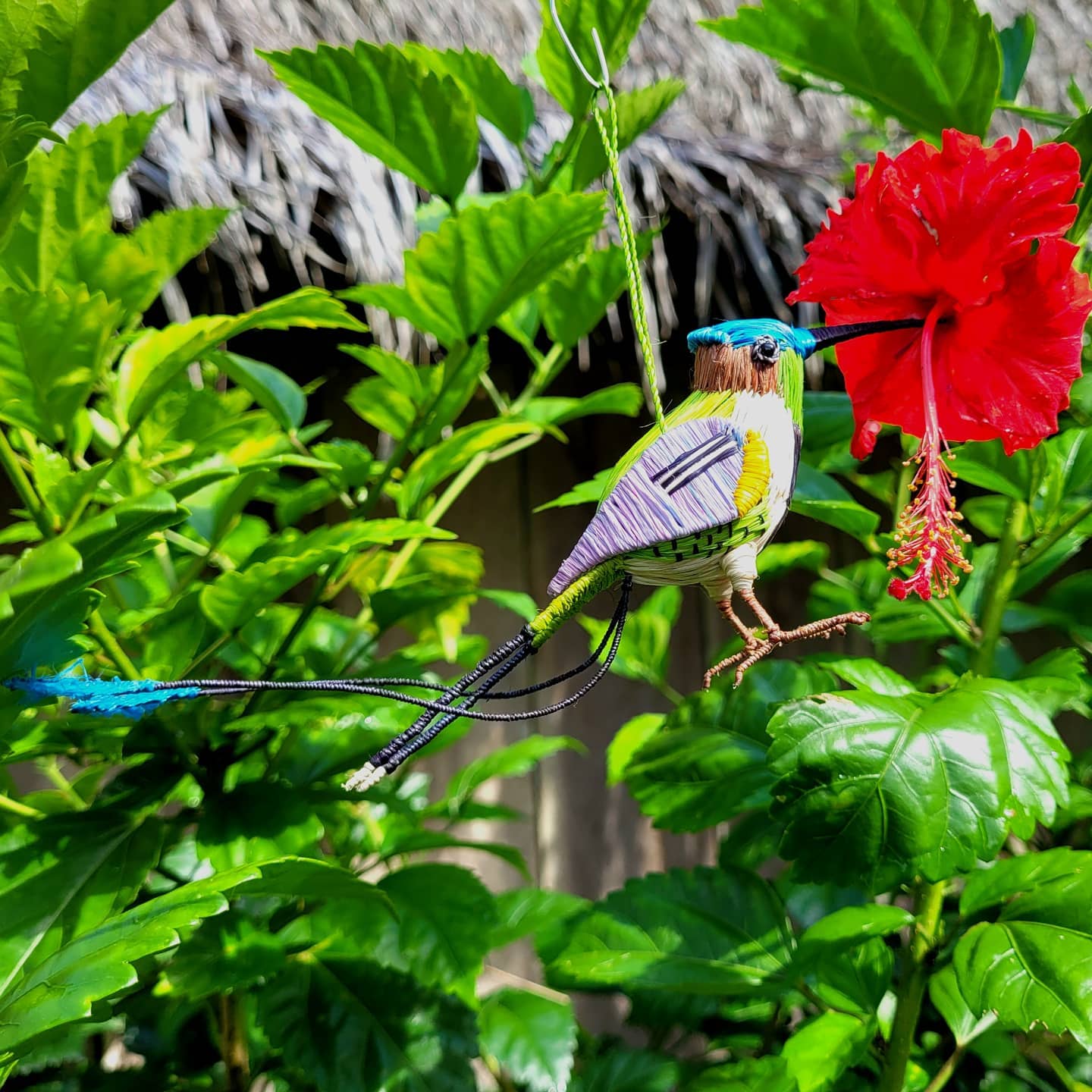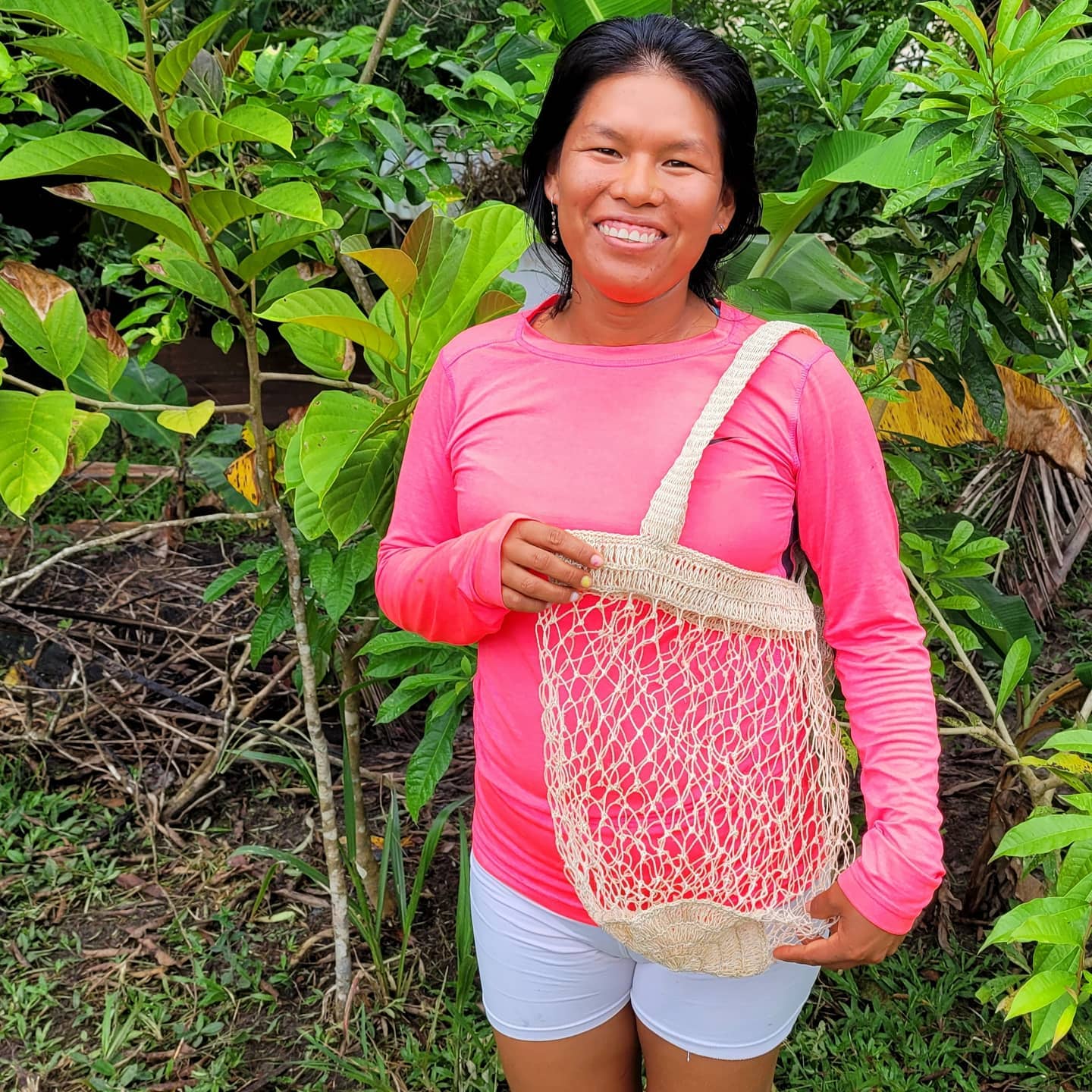Story and photos by Campbell Plowden, Executive Director, Amazon Ecology
When I arrived in Brillo Nuevo on Friday, I found that I was going to share our house with three women from Camino Verde who were there to help their team document the latest harvest of rosewood branches and attend the Chicha de Pijuayo (Pijuayo palm fruit drink) festival.
I checked in with a few artisans, had some food, and visited the maloca where people were beginning to gather for the festival.
The curaca Manuel was sitting with a small group in a circle “mameando” - this is the practice of placing a large spoonful of toasted powder of coca leaves mixed with ash in one’s cheek - the saliva slowly activates the coca. Some were also taking tastes of “ampiri” - a traditional thick liquid made from concentrated tobacco.
I greeted Manuel who I have known for years and met some guests from various countries in Europe and South America who live in an intentional community called “Aro Iris” near Nauta.
After dinner, I was tempted to return to the maloca for the manguaré drumming due to start that night, but I decided to retire to my hammock since I knew I was not going to sleep much during the main part of the festival due to start the following day and last all night.
Even though my house is at the opposite end of the village, I could clearly hear the deep resonating sound of the two drums fashioned from hollowed-out sections of a tree trunk that were four to five feet long. A friend told me you could actually hear them in Pebas many miles away. Before radios and cell phones, these drums were the best way to communicate with people at a distance.
In between spells of sleeping I awoke to the sound of the drums beating throughout the night. They stopped at dawn just before the peak of the morning bird songs greeted the day.
After breakfast, I walked back to the maloca where the Brillo Nuevo people were getting warmed up with a dance and chant and waited for the guests from other Bora villages to arrive.

Video of opening dance at Brillo Nuevo
THE PIJUAYO COMPANIONS ARRIVE AT BRILLLO NUEVO
The Chicha de Pijuayo festival began to celebrate an abundant harvest of pijuayo palm fruits. Chicha is made by removing, cleaning and mashing the yellow, orange or red pulp surrounding the seed and letting it mellow to a sour and flavorful thick drink but not to the point of becoming an alcoholic beverage.
The first half of the festival focuses on presenting the relationship between many animals who are attracted to the pijuayo fruits. These include armadillos, peccaries, monkeys and some birds that consume the palm fruits when they are ripening on the tree or have fallen on the ground. Bees, flies, wasps and dragonflies are attracted to the rich chicha.
Men from different Bora villages often come to the festival dressed with an aguaje palm leaf costume, a brown burlap bag over their head, a wooden staff with shapaha pod rattles, carved wooden masks and/or other accessories to define which creature they represent.

As each new group arrived, one or two men would act out a skit to portray their critters’ relation to pijuayo and sometimes the actions people take to keep the insects from landing in the big pot of chicha. When they started dancing, women would join the line dance and chant, circle the maloca a few times and then go inside. Once unmasked, a representative would be given a bowl of chicha to drink.

As more and more visitors arrived, I ducked away from the festivities to grab my hammock from my house and set it up next to my Camino Verde friends. This was going to be an amazing long day and night.
Video of animal characters arriving at Chicha de Pijuayo festival
LEARNING TO DANCE WITH GUSTO AND HUMILITY
After all the characters involved in the chicha de pijuayo festival at Brillo Nuevo were welcomed into the maloca, the festival moved to its next phase. Two men leading a group from their Bora community in turn entered the maloca and began to dance in a circle and chant to the beat of their maraca. Soon two women joined behind them to add their higher pitched voices to the song. Other women then formed an outer ring to join the dance. Some leaders shifted from one song to another during their turn; others ended after just one. The coordinated movement and sounds were powerful and mesmerizing.
I saw other visitors participating in the dances so after observing for a while, I got up the courage to join one end of the men’s line next to the leader of the Arco Iris group. I could basically move in cadence with the rhythm, but my foot movements were more freestyle than in synchrony with my fellow dancers. This worked OK until the group suddenly changed directions putting me in the leader position, and I stumbled badly trying to figure out what I was expected to do. It felt like some of my artisan friends appreciated my attempt to join in, but I was clearly out of my depth. It was a relief when the dance was over.
During a break, I asked one of the experienced men to step outside and teach me the basic steps. They were not that hard, but it would clearly take practice.
I was still humbled by my fumbling debut so I watched a few more dances until a woman came by, took my hand and brought me to her side in the outer ring. Men did not generally dance with women in this setting, but I appreciated that she patiently helped me gain some confidence to move in time with the others.
During the next dance, I was equally grateful to Javan from Brillo Nuevo who motioned to me with his finger to join him in the middle of the men’s circle. I was far from perfect, but it began to feel more natural to move my feet and start to learn when and how to shake my rattle that artisan friend Jhimi had made for me the day before.

THE BORA HEART IN SONG
As the night progressed, I took breaks between dances to drink some water, chat with friends, and nap in my hammock. As each community group entered the maloca in turn, I saw the dance steps were the same, but distinct songs that were repeated. In time I began to sing along with a few parts.
During a break, I asked Lucio what the previous song was about. He told me it was about one of the birds that ate pijuayo fruits, but he couldn’t tell me the details. Some of the words were Bora, but most were a language he didn’t know. I imagined the curaca Manuel or other chant leaders would know more, but their literal meanings were not common knowledge.
Someone else told me the non-Bora words might be the language of a bird. A third person said that while he knew all of the traditional songs from the festivals by heart, he learned them by hearing them over and over and repeating them - the same way that parrots use mimicry to learn human words.
A teacher in Brillo Nuevo was preparing materials to help Bora children better understand their language and culture. At some point he would have something that would explain the meaning of their traditional festivals and songs.
The literal meaning of the chants, though, did not matter to the people at the festival. There were non-Bora guests at this event, but it was not a show put on to entertain tourists. It was a special event organized by Bora people for Bora people who understood its meaning at a visceral level.
Since their lifestyle is so similar to people living in many other native and campesino communities in the region, I have sometimes asked people from Brillo Nuevo what it meant to them to be an indigenous person and specifically Bora. The answers have been sincere, but they often seemed the same general responses I have heard from people from other backgrounds. Maybe such distinctions can’t be easily described with words, but I felt honored to witness a clear expression of what being a Bora meant to those people that night fully immersed in their unique cultural tradition.

Link to video: https://www.facebook.com/1077666538/videos/pcb.10223155293325510/689463815508503
THE LAST DANCES
I entered the men’s dance circle after midnight next to my friend Jacmen. I immediately felt like I had jumped on a bucking bronco when my partner to the right began to pull me sideways, forward and back. It was hard to keep up because he was clearly drunk. I appreciated that Javan who had asked me to join him in the circle earlier that night came in between me and this inebriated fellow. His reprieve, however, was short-lived. I was again being jerked around faster than I could keep up so I returned to a seat on a log near my hammock. An elder to my side expressed his irritation about people drinking too much at this festival.
While many Amazon peoples prepare alcoholic drinks from yucca and other plants, this was not a traditional Bora practice. The booze they were drinking at the festival was beer and “tragos” (hard liquor drinks) sold by an enterprising woman outside the maloca.
I slept off and on again until about 5 am. Listening to the mesmerizing sounds of the chanting from my hammock brought me back to the first night I spent at a Tembé Indian village in Brazil in 1993. Back then I had also joined a traditional gathering with vigorous dancing and chants that permeated my consciousness through the night. Two years later, one chant I had half-learned that night kept going through my mind like a broken record. My desire to make this song whole became a key landmark of an intense three-year journey with the Tembé people.
As the natural light from sunrise started entering the maloca, I sensed the last dance was about to begin, and I joined in without hesitation. Manuel, the curaca of Brillo Nuevo, led the circle around and around through song after song until it reached a joyous crescendo at dawn. I had felt welcomed and appreciated in many ways in this community for 14 years, but melding into this circle dance gave me a feeling of unity with its people I had never experienced. I can’t say why, but this felt like the end of a chapter in my relationship with them and perhaps my work. It was an unusual feeling of not knowing what might come next.





